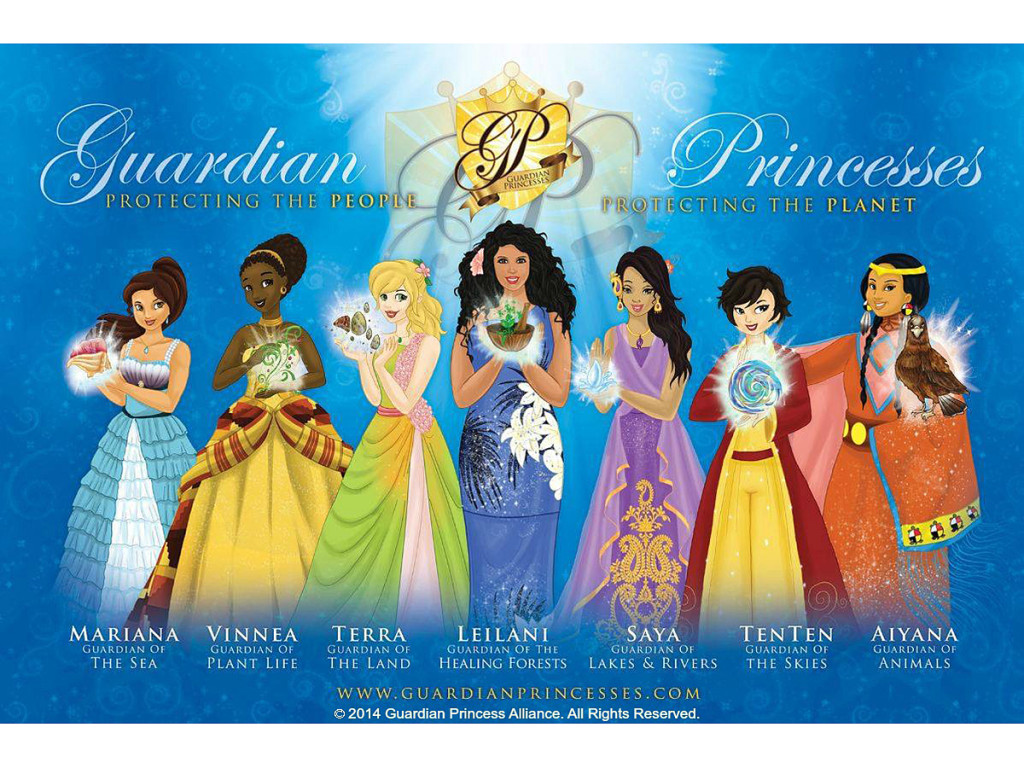
Protecting our planet’s environment and people with their unique powers, the Guardian Princesses — Mariana, Vinnea, Terra, Leilani, Saya, Ten Ten and Aiyana — know no bounds, but to love and respect all no matter any differences.
But, there’s another group that needs to be recognized.
Often together in the media and cultural studies common rooms, the student interns of the Guardian Princesses project gather to, as their mission statement reads, “transform the cultural meaning of princesses and princes into positive role models who take action to protect living beings and the planet for future generations.”
No matter if they, like the princesses themselves, come from diverse backgrounds from skills to culture, they’ve become an effective team driven by a common sentiment beyond their mission statement — that it’s alright to be yourself, no matter what society dictates.
This project started as an effort by media and cultural studies Professor Setsu Shigematsu to offer her daughter a more feminist princess by writing a series of story stories about Princess Terra. Guardian Princesses has now greatly expanded into an educational series — including books, music and appearances at elementary schools — that stresses inclusivity and empowerment. Essentially, Guardian Princesses strives to redefine how society, especially children, characterize princesses.
This is spearheaded by the collective efforts of not only the professor, but the student interns who take on numerous roles from drafting stories to illustrating pictures, from marketing to celebrity outreach and from researching to teaching.
Oftentimes, students take on various roles, such as fourth-year creative writing major Princess Fernandez, who went from doing outreach to drawing and researching the princesses. When I went to visit a breakout session, where everyone came together and bounced off ideas while working on various projects, Fernandez utilized her major as she further developed a new story. In addition to contributing to the writing process, Fernandez has also drawn concept art for the newest addition to the Guardian Princesses, Leilani, as well as storyboarding possible video projects.
Like Shigematsu’s daughter, Fernandez’s niece has also been exposed to Guardian Princesses. Explaining her concern that her niece continuously watched toy reviews on YouTube that only displayed princesses as beautiful damsels in distress, she would read the books to her whenever she got a chance.
“When she asked about Princess Ten Ten, she would say ‘where is her prince?’” said Fernandez. “I would reply: ‘Well, she doesn’t need a prince.’”
Fernandez explained her own affinity to Princess Ten Ten’s story, which details her struggles with being bullied for being different: “I love the range of emotions that Princess Ten Ten goes through. We get to see her sad, get to see her happy, get to see her struggling, get to see her at her most empowered.” She admits to even drawing fan art for the series, expressing her opinion that it’s important to see girls of color in positions of empowerment.
Other students expressed the same sentiment, such as fifth-year political science major and media and cultural studies minor Lillian Mehler, who grew up in Brazil before immigrating to America at age 10. “For us, looking like Barbie was cool,” Mehler said.
She went on to recount that adults would try to steer her toward being more feminine, like her childhood friend’s mother. ”If we tried to play with her brother’s toys, then her mom would be like ‘oh you guys play with the dolls or go play school,’” she mused.
When her cousin decided to take up professional soccer, which is considered a man’s sport in Brazil, her family members would comment “Oh, I think she’s a lesbian,” or “Oh, she’s so buff.”
She admits that even “growing up in Brazil, I would have benefited from these stories.” Although the one Latin American princess, Mariana, was not Brazilian, Mehler still felt a connection to her. ”There are Portuguese words (in the story) and Mariana is a popular Brazilian name, I was really drawn to it. It’s really cool to see a princess that is like me.”
In an age where Barbie dolls and Disney princesses reign supreme, these students are part of a counterculture that they have helped form themselves. Currently, the team is focused on developing Leilani, who has a curvy body instead of the typical thin-as-a-stick figure. Although she could not share anything about her official backstory, Fernandez noted that “there were tears” during the development process.
With the Guardian Princesses from multicultural and multiracial backgrounds, their narratives can include issues not often discussed in mainstream media for children. In their published series thus far, the princesses have touched upon issues about bullying, land seizures and pollution. The princesses themselves also represent marginalized groups, such as women with curvy figures or gender non-binary individuals.
In contrast to mainstream princesses or female figures, Guardian Princesses focus on inclusivity no matter the differences or, as the student interns have interpreted, on the importance of accepting yourself. It’s a message that comes off cliche, but one that has been ignored still in mainstream media.
To rectify this, the staff and students at Guardian Princesses have worked together to further reach out to the community around UCR and beyond via different mediums of media. Currently, with the upcoming release of a Spanish version of Princess Mariana’s story, they have been holding reading sessions at elementary schools. Furthermore, they are adapting the stories into a musical for young audiences with the aid of Chari Arespacochaga, a director with experience in crafting theater productions.
With these efforts conducted by a staff member and students who believe in a common goal, the Guardian Princesses will surely make their way to mainstream media and redefine what it means to be a princess.








